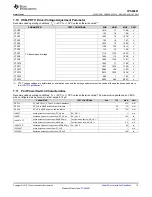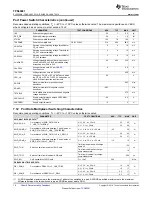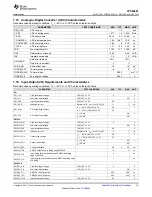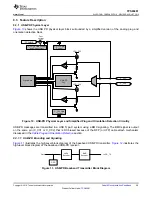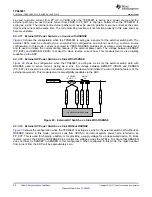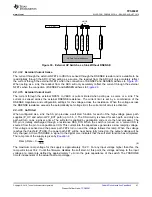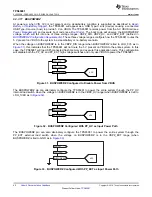
27
SLVSDC2B – FEBRUARY 2016 – REVISED AUGUST 2016
Product Folder Links:
Copyright © 2016, Texas Instruments Incorporated
9 Detailed Description
9.1 Overview
The TPS65981 is a fully-integrated USB Power Delivery (USB-PD) management device providing cable plug and
orientation detection for a USB Type-C and PD plug or receptacle. The TPS65981 communicates with the cable
and another USB Type-C and PD device at the opposite end of the cable, enables integrated port power
switches, controls an external high current port power switch, and multiplexes high-speed data to the port for
USB2.0 and supported Alternate Mode sideband information. The TPS65981 also controls an attached super-
speed multiplexer to simultaneously support USB3.0/3.1 data rates and DisplayPort video.
The TPS65981 is divided into six main sections: the USB-PD controller, the cable plug and orientation detection
circuitry, the port power switches, the port data multiplexer, the power management circuitry, and the digital core.
The USB-PD controller provides the physical layer (PHY) functionality of the USB-PD protocol. The USB-PD data
is output through either the C_CC1 pin or the C_CC2 pin, depending on the orientation of the reversible USB
Type-C cable. For a high-level block diagram of the USB-PD physical layer, a description of the features and
more detailed circuitry, refer to the
section.
The cable plug and orientation detection analog circuitry automatically detects a USB Type-C cable plug insertion
and also automatically detects the cable orientation. For a high-level block diagram of cable plug and orientation
detection, a description of the features and more detailed circuitry, refer to the
section.
The port power switches provide power to the system port through the VBUS pin and also through the C_CC1 or
C_CC2 pins based on the detected plug orientation. For a high-level block diagram of the port power switches, a
description of the features and more detailed circuitry, refer to the
section.
The port data multiplexer connects various input pairs to the system port through the C_USB_TP, C_USB_TN,
C_USB_BP, C_USB_BN, C_SBU1 and C_SBU2 pins. For a high-level block diagram of the port data
multiplexer, a description of the features and more detailed circuitry, refer to the
section.
The power management circuitry receives and provides power to the TPS65981 internal circuitry and to the
LDO_3V3 output. For a high-level block diagram of the power management circuitry, a description of the features
and more detailed circuitry, refer to the
section.
The digital core provides the engine for receiving, processing, and sending all USB-PD packets as well as
handling control of all other TPS65981 functionality. A small portion of the digital core contains non-volatile
memory, called boot code, which is capable of initializing the TPS65981 and loading a larger, configurable
portion of application code into volatile memory in the digital core. For a high-level block diagram of the digital
core, a description of the features and more detailed circuitry, refer to the
section.
The digital core of the TPS65981 also interprets and uses information provided by the analog-to-digital converter
ADC (see the
section), is configurable to read the status of general purpose inputs and trigger events
accordingly, and controls general outputs which are configurable as push-pull or open-drain types with integrated
pull-up or pull-down resistors and can operate tied to a 1.8-V or 3.3-V rail. The TPS65981 is an I
2
C slave to be
controlled by a host processor (see the
section), an SPI master to write to and read from an
external flash memory (see the
section), and is programmed by a single-wire debugger
(SWD) connection (see the
Single-Wire Debugger Interface
section).
The TPS65981 also integrates a thermal shutdown mechanism (see
section) and runs off of
accurate clocks provided by the integrated oscillators (see the
section).

